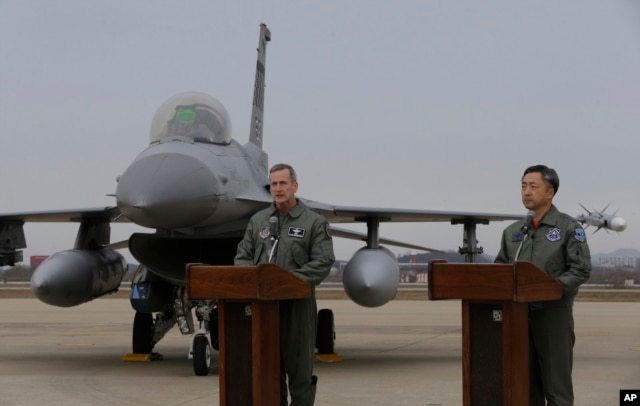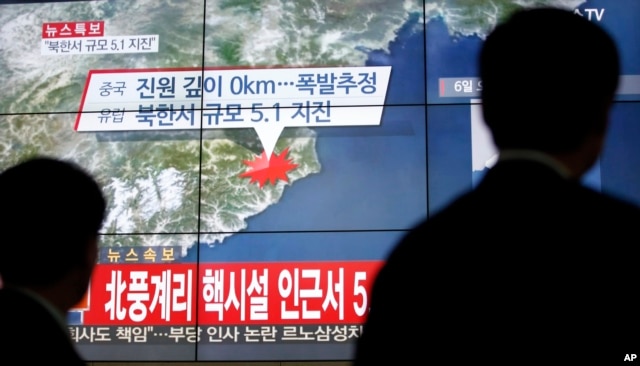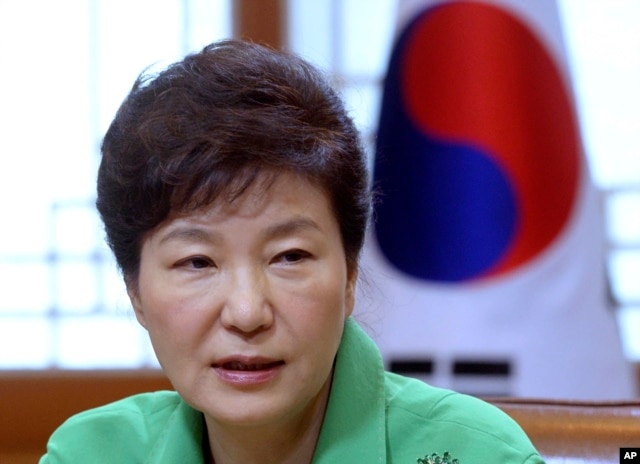S. Korea: US, Seoul Mull Options to Deploy ‘Strategic Assets’

A South Korean official said Monday Seoul and the United States are discussing other U.S. «strategic assets» that can be deployed on the Korean peninsula, a day after the U.S. flew a long-range B-52 bomber over South Korea in an apparent response to North Korea’s latest nuclear weapons test.
«The United States and South Korea are continuously and closely having discussions on additional deployment of strategic assets,» Kim Min-seok, a spokesman at the South Korean Defense Ministry, told Reuters news agency. He declined to give specifics.
The French news agency (AFP) and South Korea’s Yonhap news agency reported such assets may include the nuclear-powered aircraft carrier USS Ronald Reagan – currently based in Japan – B-2 bombers, nuclear-powered submarines and F-22 stealth fighter jets.
Lt. Gen. Terrence O’Shaughnessy, left, 7th Air Force commander of the U.S. Forces to Korea, speaks in front of a U.S. F-16 fighter jet as South Korean Air Forces Commander Lee Wang-geun listens at the Osan Air Base in Pyeongtaek, South Korea, Jan. 10, 201
However, the Pentagon on Monday refused to discuss specifics.
«I don’t think we’re ready to reveal everything that is up our sleeve,» Pentagon spokesman Navy Capt. Jeff Davis said.
When pushed about military hardware currently available to U.S. forces in Japan and Korea, Davis said «every asset of the United States military» was potentially available to demonstrate the United States’ commitment to its allies.
The military deployed a Boeing WC-135 aircraft to the region shortly after North Korea’s nuclear test, according to Davis. The aircraft is currently conducting flights in support of the Department of Energy as «one piece of a larger puzzle» of intelligence apparatuses assessing the situation.
Sunday’s flight of the B-52 came hours after North Korean leader Kim Jong Un defended last Wednesday’s test of an alleged hydrogen bomb as «the legitimate right of a sovereign state and a fair action that nobody can criticize» during a speech to the Ministry of the People’s Armed Forces.
South Korea has urged the international community to impose harsh sanctions against the North for the nuclear test, its fourth since 2006.
The U.S. military has been slowly «rebalancing» to the Asia-Pacific region since 2004, a defense official told VOA Monday. He added that about 60 percent of the U.S. Navy operates in the Pacific region.
The White House said Monday the U.S. is closely consulting with its allies and is committed to preserving the international unanimity of opinion when it comes to confronting North Korea.
Avoid raising tensions
Chinese Foreign Ministry spokesman Hong Lei, responding to a question about the U.S. flight the previous day, called on all sides to avoid raising tension.
«Safeguarding the peace and stability of northeast Asia accords with all parties’ common interests. We hope all relevant parties can maintain restraint, proceed cautiously, and avoid successively escalating tensions,» Hong said at a regular briefing.
Arriving at Osan Air base in South Korea, Curtis Scaparrotti, commander of U.S. Forces and the United Nations Command in South Korea, put U.S. forces on their highest level of alert Monday in case of any provocation from North Korea.
China’s Ministry of Environmental Protection also announced that more than 500 people have been involved in monitoring for radiation along the North Korea border and, so far, no radioactive pollution has been found.
«We have ruled out large-scale emissions,» said Guo Chengzhan, deputy director of the State Bureau of Nuclear Safety. «We are still monitoring on possible radiation in small doses.»
FILE – People walk by a screen showing the news reporting about an earthquake near North Korea’s nuclear facility, in Seoul, South Korea, Jan. 6, 2016.
‘Glorified’ previous leaders
Meanwhile, the North’s state-run Korean Central News Agency published a photo of Kim posing with hundreds of scientists, workers and other officials who participated in last week’s test, praising them for «having glorified» Kim Jong Il, his late father, and Kim Il Sung, his grandfather and state founder.
Seoul also continued anti-Pyongyang propaganda broadcasts across the border Monday, while the Unification Ministry announced it would restrict access to Kaesong, a jointly run factory park a few kilometers across the border in North Korea.
Beginning Tuesday, a Unification Ministry official said South Korea would limit the number of South Koreans allowed to stay in the park overnight to the «minimum necessary level,» from 800 to 650.
The industrial complex provides jobs for more than 50,000 North Koreans employed by more than 100 South Korean companies.
South Korean President Park Geun-hye is to speak to the nation about raised tensions with the North on Wednesday, a presidential official said.
On the diplomatic front, South Korea said its chief nuclear negotiator planned to meet with his U.S. and Japanese counterparts Wednesday to discuss a response to North Korea, and the next day, he would meet China’s nuclear envoy in Beijing.
FILE – South Korean President Park Geun-hye speaks during a regular meeting at the presidential house in Seoul, South Korea.
Sunday’s bomber flight
On Sunday, the B-52 bomber, which is capable of carrying nuclear weapons, was seen flying over Osan Air Base, located 72 kilometers south of the border that separates the two Koreas, before heading back to its home base on nearby Guam. The bomber was accompanied by two fighter planes from the U.S. and South Korea.
U.S. Navy Admiral Harry B. Harris Jr., the commander of the U.S. Pacific Command, issued a statement calling the flight a demonstration of the ironclad U.S. commitment to our allies in South Korea, in Japan, and to the defense of the American homeland.»
Lieutenant-General Terrence O’Shaughnessy, the deputy commander of the joint United States-South Korean military command, told reporters after the flight that the U.S. «remains steadfast» in the defense of South Korea «and to maintaining stability on the Korean Peninsula, to include extended deterrence provided by our conventional forces and our nuclear umbrella.»
The U.S. also sent a long-range bomber over South Korea in 2013, shortly after the North carried out its third nuclear test.
Pentagon correspondent Carla Babb and White House correspondent Aru Pande contributed to this report





